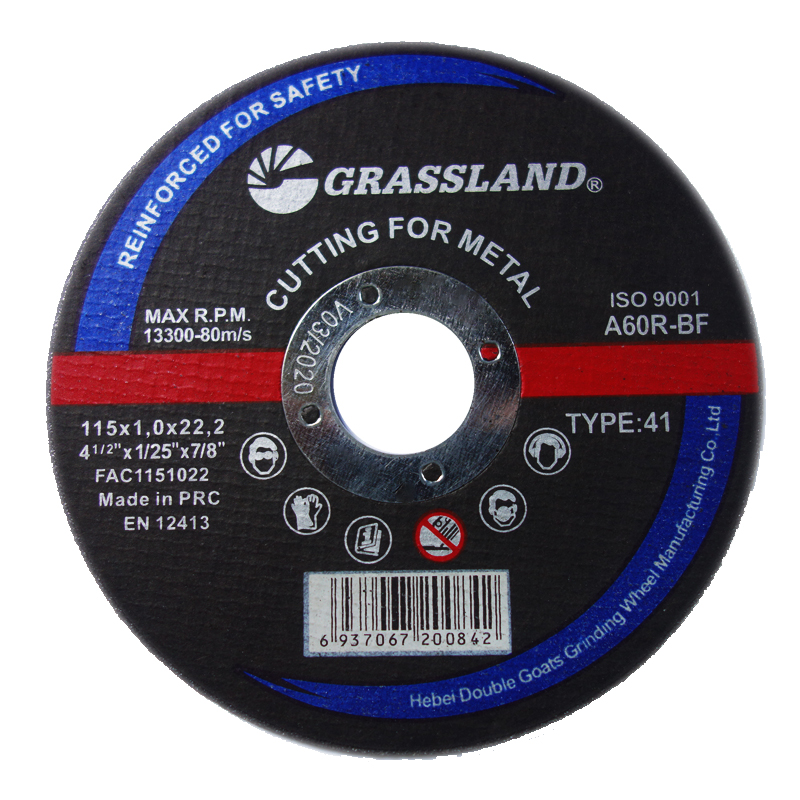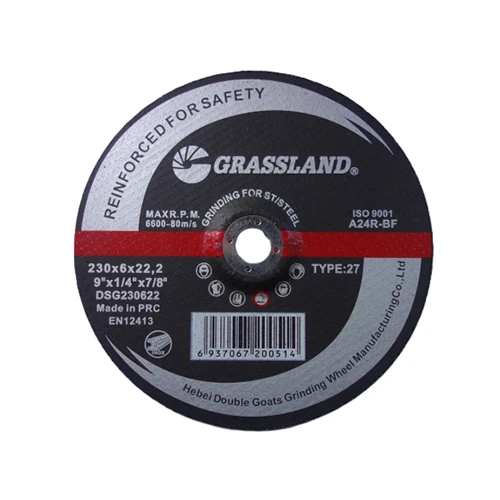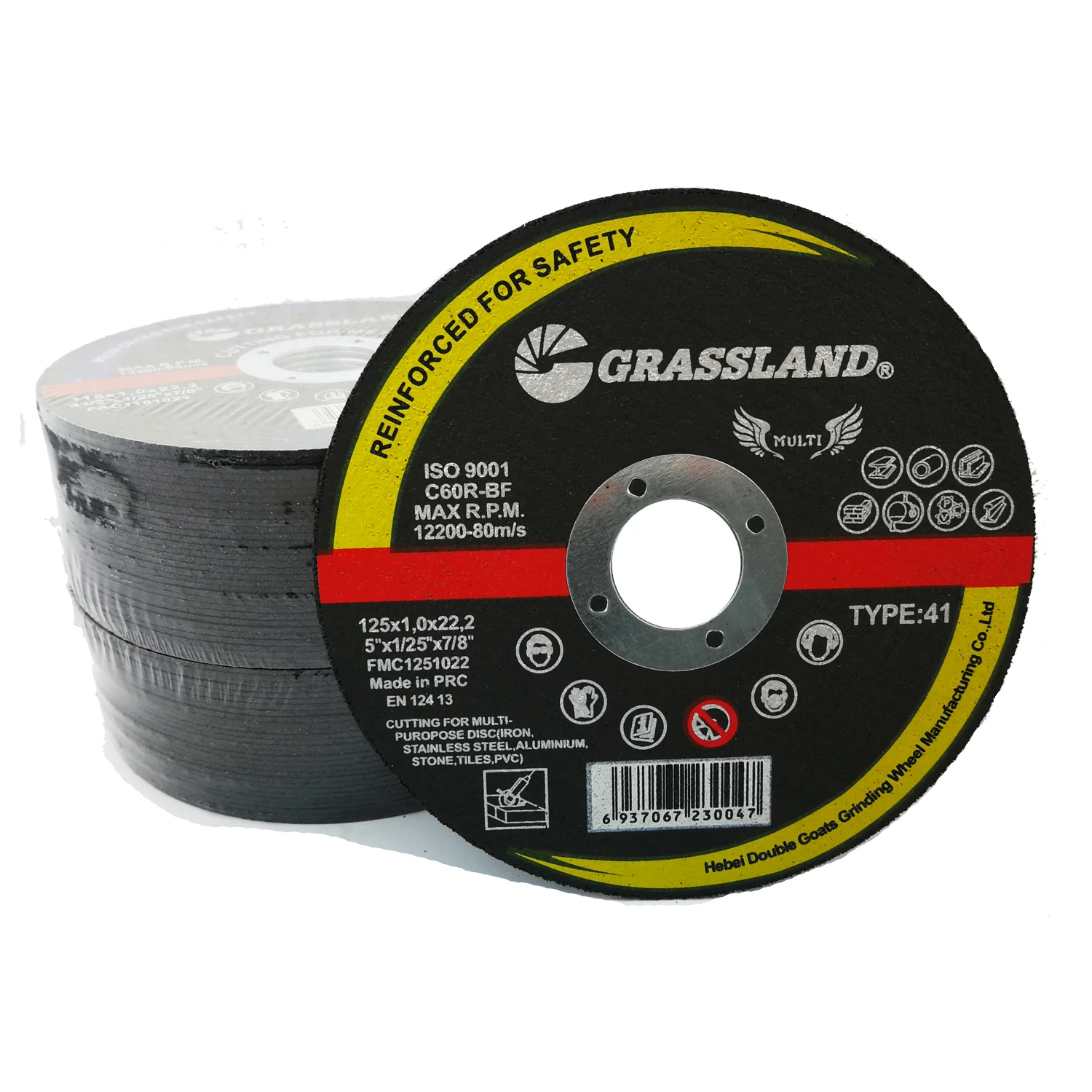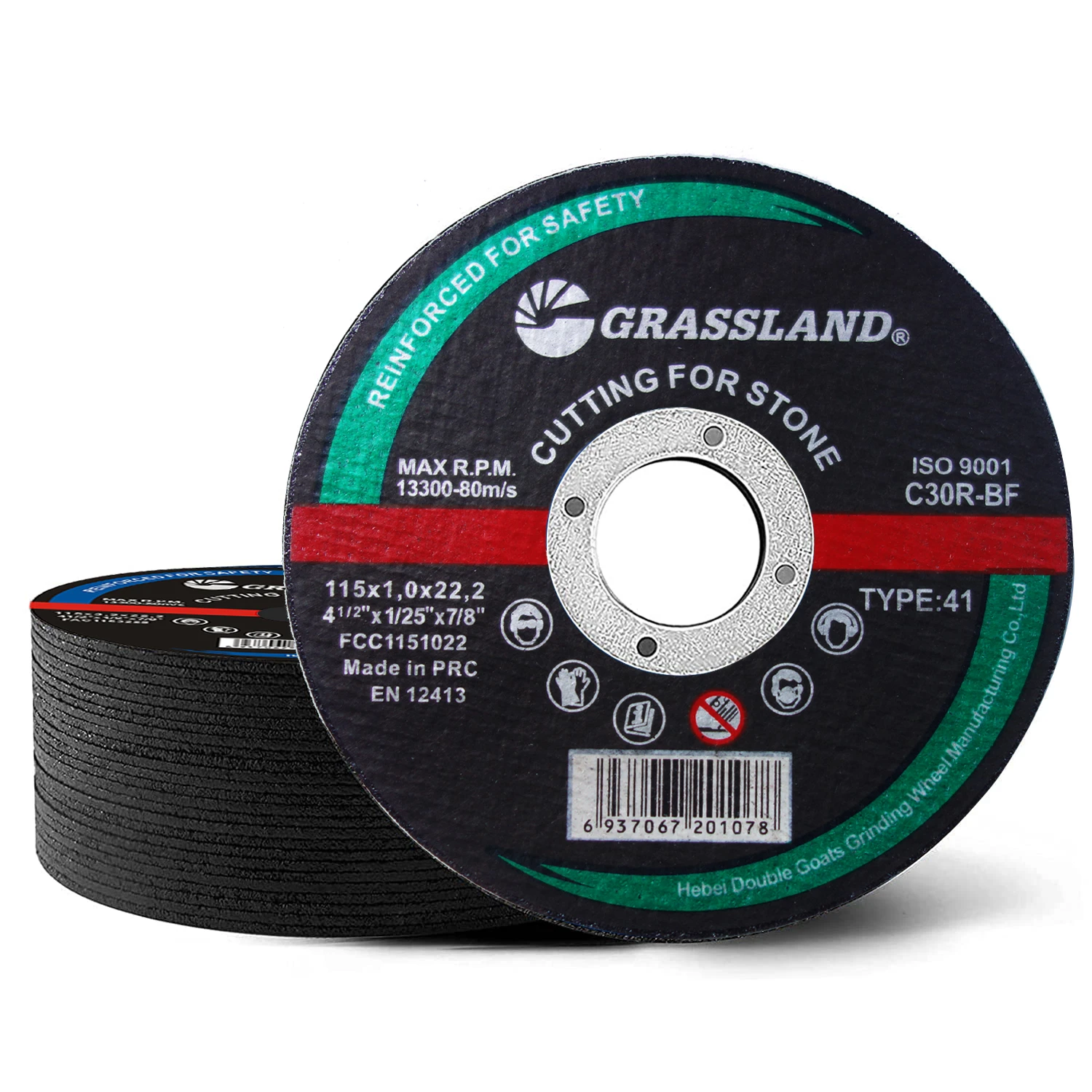The Foundation of Precision: Understanding abrasive metal cutting disc Technology
In industrial fabrication and construction, the efficiency and precision of material processing are paramount. The abrasive metal cutting disc stands as a cornerstone technology, essential for shaping, sizing, and preparing various metal components. These high-performance consumables are engineered to deliver rapid, clean, and accurate cuts across a spectrum of metallic materials, from carbon steel to stainless alloys. This article delves into the intricate world of these cutting tools, exploring their manufacturing processes, technical advantages, diverse applications, and critical factors for selection and deployment in demanding B2B environments. We will also examine industry trends, offer vendor comparison insights, discuss custom solutions, and present compelling case studies to highlight their operational impact.

Manufacturing Process of an Abrasive Cutting Disc
The production of a high-quality abrasive metal cutting disc is a complex, multi-stage process requiring stringent quality control to ensure performance, durability, and safety. Unlike methods such as casting or forging, which produce the metal workpieces, the manufacturing of these discs relies on precision material blending and controlled thermal curing.
Schematic Steps in Disc Manufacturing:
1. Raw Material Selection & Preparation
- Abrasive Grains: High-grade aluminum oxide (Al2O3) is the primary abrasive for steel, offering excellent hardness and friability. Silicon carbide may be used for non-ferrous metals.
- Resinoid Bond: Phenolic resins are commonly used, providing thermal stability and strength.
- Reinforcement: Multiple layers of high-tensile fiberglass mesh are crucial for structural integrity and safety during high-speed rotation.
- Fillers & Additives: Cryolite, iron pyrite (FeS2), and other agents enhance cutting performance, reduce heat, and improve disc life.
2. Mixing & Blending
Abrasive grains, resin, fillers, and other additives are precisely weighed and thoroughly mixed in specialized blenders to ensure homogeneous distribution. This step is critical for consistent disc performance.
3. Forming & Pressing
The blended mixture is fed into molds, where it is layered with fiberglass reinforcement. High-tonnage hydraulic presses then compress the material at specific pressures to form the disc's desired thickness and density, including the central arbor hole.
4. Curing & Hardening
The formed discs undergo a controlled thermal curing process in industrial ovens. This "baking" polymerizes the resin bond, transforming the disc into a rigid, durable cutting tool. Temperature and duration are critical for achieving optimal bond strength and disc hardness.
5. Finishing & Inspection
After curing, discs are inspected for dimensional accuracy, concentricity, and visual defects. Labeling and packaging follow. Key testing standards include ISO 12413 for safety requirements and ANSI B7.1 for abrasive wheel safety, ensuring products meet stringent performance and safety criteria. Burst speed tests, lateral run-out tests, and cutting performance evaluations are routinely conducted.
Target industries for these precision tools include petrochemical, metallurgy, shipbuilding, automotive, water supply & drainage, and general metal fabrication. The advantages of using optimized discs include significant energy saving due to faster, cleaner cuts that require less force, and extended service life reducing replacement frequency and downtime. While the disc itself does not offer corrosion resistance, its ability to create precise cuts minimizes material damage and heat zones, which can be critical for subsequent corrosion-resistant treatments or coatings on the metal workpiece.
Technical Specifications and Performance Parameters
Understanding the technical specifications of an abrasive metal cutting disc is crucial for selecting the right tool for specific applications. Performance is dictated by a combination of material composition, design, and manufacturing precision.
Key Specifications: Product Example (4.5inch Steel Abrasive Cutting Discs 115mm 115x1x22.2mm)
| Parameter | Specification | Description/Implication |
|---|---|---|
| Outer Diameter (OD) | 115 mm (4.5 inches) | Standard size for angle grinder discs for steel, suitable for hand-held angle grinders. |
| Thickness | 1.0 mm | Ultra-thin design for fast, precise, and burr-free cuts, minimizing material waste and heat generation. |
| Arbor Hole Diameter | 22.2 mm (7/8 inches) | Standard bore size compatible with most angle grinders globally. |
| Abrasive Material | Premium Aluminum Oxide | Optimized for cutting steel and other ferrous metals. High hardness and self-sharpening properties. |
| Bonding Type | Reinforced Resinoid | Ensures disc integrity at high speeds and temperatures, preventing premature shattering. |
| Max Operating Speed | 80 m/s | The maximum safe peripheral speed, crucial for operator safety and efficient cutting. |
| Max RPM | 13,300 RPM | Maximum rotations per minute, directly related to the disc's diameter and operating speed. Must match or exceed grinder's RPM. |
| Application | Steel, Stainless Steel, Ferrous Metals | Specifically engineered for cutting various types of steel with optimal performance. |
| Safety Standard | EN 12413 / ISO 9001 | Compliance with European safety standards for abrasive products and quality management systems. |
These specifications are not merely numbers; they directly influence the disc's performance. For instance, the 1.0 mm thickness ensures minimal kerf loss and reduced material deformation, while the high maximum RPM indicates suitability for powerful industrial angle grinders. The choice of premium aluminum oxide abrasive grains for a abrasive metal cutting disc specifically targets the hardness and ductility of steel, ensuring optimal material removal and disc life. In addition to these, critical performance indicators include cut rate (material removed per unit time), burr formation (cleanliness of cut edge), heat generation (impact on workpiece integrity), and disc life (total cuts or material removed before replacement).

Application Scenarios and Industry Trends
The versatility of the abrasive metal cutting disc makes it indispensable across numerous industries. These discs are the workhorses for precise cutting operations where speed, accuracy, and safety are non-negotiable.
Typical Application Scenarios:
- Structural Steel Fabrication: Cutting beams, pipes, and rebar to length in construction and infrastructure projects.
- Shipbuilding and Marine: Sectioning steel plates and profiles for vessel construction and repair.
- Automotive Manufacturing & Repair: Cutting exhaust pipes, chassis components, and body panels.
- Pipeline Construction: Precise cuts on steel pipes for oil & gas, water, and sewage systems, ensuring tight fit-up for welding.
- Foundry Operations: Riser and gate removal from metal castings.
- Maintenance, Repair, and Operations (MRO): General-purpose metal cutting in industrial facilities.
Current Industry Trends:
- Enhanced Safety Features: Continuous improvements in disc design, materials, and manufacturing processes to reduce the risk of shattering and kickbacks, aligning with stricter safety regulations (e.g., EN 12413).
- Sustainability and Longevity: Development of discs with extended service life, reducing waste and replacement frequency, contributing to greener operations.
- Reduced Heat Generation: Advanced formulations and thinner designs aim to minimize heat input into the workpiece, preventing material distortion and metallurgical changes, especially critical for stainless steel.
- Specialization: Growing demand for application-specific discs, such as those optimized for stainless steel (contaminant-free) or specific material thicknesses, leading to better performance and efficiency.
- Ergonomics and User Comfort: Discs designed for smoother, faster cuts reduce operator fatigue and improve productivity, particularly for angle grinder discs for steel.
The market for cutting discs is evolving towards higher performance, greater safety, and increased specialization to meet the diverse needs of modern industrial applications. This evolution ensures that businesses can achieve superior results with greater operational efficiency.
Technical Advantages and Vendor Comparison
The technical advantages of a well-engineered abrasive metal cutting disc translate directly into operational benefits, impacting cost-efficiency, productivity, and workpiece quality.
Key Technical Advantages:
- High Cutting Speed: Optimized abrasive grain and bond systems enable faster material removal, reducing project timelines.
- Reduced Burr Formation: Thin disc profiles (e.g., 1.0 mm) lead to cleaner cuts, minimizing the need for secondary finishing operations, thus saving time and labor.
- Lower Heat Generation: Specialized formulations and design features dissipate heat more effectively, preventing discoloration, warping, and metallurgical changes in sensitive materials like stainless steel.
- Extended Disc Life: High-quality raw materials and robust bonding agents contribute to a longer lifespan, reducing consumable costs and machine downtime for disc changes.
- Enhanced Safety: Multi-layer fiberglass reinforcement and adherence to international safety standards (EN 12413) significantly reduce the risk of disc breakage during operation.
- Versatility: While optimized for steel, many high-performance discs offer good performance across various ferrous and non-ferrous metals, making them a flexible choice for general fabrication.
Vendor Comparison: Factors to Consider
| Factor | Premium Vendor (e.g., cutoffdiscs.com) | Standard Vendor |
|---|---|---|
| Raw Material Quality | Virgin premium aluminum oxide, high-grade phenolic resins, multiple layers of industrial-grade fiberglass. | Recycled or lower-grade abrasives, general-purpose resins, fewer layers of fiberglass. |
| Manufacturing Process | Automated precision blending, high-tonnage pressing, strictly controlled multi-stage thermal curing. ISO 9001 certified. | Less precise blending, standard pressing, basic single-stage curing. Variable quality control. |
| Performance Metrics (Cut Speed) | Typical steel beam cut time: ~5-8 seconds (e.g., 50x50x5mm angle steel) | Typical steel beam cut time: ~10-15 seconds |
| Disc Life (Cuts per disc) | Average 30-50 cuts (50x50x5mm angle steel) | Average 15-25 cuts |
| Safety & Certifications | EN 12413, ISO 9001, OHSAS 18001. Rigorous burst speed testing. | May meet basic local standards, less comprehensive third-party certifications. |
| Cost vs. Value | Higher initial cost, significantly lower overall cost per cut due to extended life, faster cutting, and reduced labor. | Lower initial cost, higher overall cost per cut due to frequent replacements, slower operation, and potential secondary finishing. |
When evaluating suppliers for angle grinder discs for steel, B2B decision-makers must look beyond the initial price. The total cost of ownership, which includes disc life, cutting speed, labor costs, and the quality of the final cut, often demonstrates the superior value of premium, high-performance discs. Authoritative references like ISO and EN standards are critical benchmarks for ensuring product safety and quality.
Customized Solutions and Application Case Studies
While standard abrasive metal cutting disc products address a wide range of needs, certain specialized industrial applications benefit immensely from customized solutions. Leading manufacturers often provide tailored abrasive solutions to meet unique client requirements.
Customization Capabilities:
- Specific Abrasive Blends: Developing custom grain mixes (e.g., Zirconia Alumina for tough alloys) or special coatings to optimize performance for exotic metals or particularly hard materials.
- Tailored Bond Systems: Adjusting resin hardness, flexibility, and temperature resistance to suit specific cutting conditions (e.g., wet cutting, extreme heat applications).
- Dimensions and Arbor Hole Sizes: Producing non-standard diameters or arbor hole sizes to fit specialized cutting machines or unique tool requirements.
- Contaminant-Free Discs: For critical stainless steel or nuclear applications, discs can be manufactured entirely free of iron, sulfur, and chlorine to prevent material contamination.
- Packaging and Branding: Custom packaging, labeling, or private branding options for large-volume industrial clients.
Application Case Studies:
Case Study 1: Large-Scale Pipeline Project in the Middle East
A major energy infrastructure company faced challenges cutting thick-walled carbon steel pipes (up to 12mm thickness) in remote desert conditions. Standard angle grinder discs for steel were experiencing rapid wear and high heat generation, causing slow progress and operator fatigue. A leading disc manufacturer provided a customized 125x1.6x22.2mm disc with a specialized high-performance Zirconia Alumina abrasive blend and an enhanced bond system for extreme durability and reduced heat. This resulted in a 30% increase in cutting speed, a 50% extension in disc life, and significantly less heat-affected zone on the pipes, leading to a projected 15% reduction in overall project time and associated costs.
Case Study 2: Automotive Production Line for Stainless Steel Exhaust Systems
An automotive OEM required exceptionally clean, burr-free cuts on thin-gauge stainless steel tubing to minimize post-processing and prevent contamination that could lead to corrosion. Standard discs often left excessive burrs and caused heat discoloration. The solution involved a ultra-thin 115x0.8x22.2mm abrasive metal cutting disc manufactured with a specific blend of white aluminum oxide and iron, sulfur, and chlorine-free binders. This customization yielded cuts with minimal burr, no discoloration, and reduced the need for secondary deburring by 70%, dramatically improving throughput and product quality on their automated cutting stations.
These case studies highlight how tailored abrasive solutions can address complex industrial challenges, demonstrating clear economic and operational advantages. Partnering with a manufacturer capable of delivering such specialized products is a key strategic decision for businesses seeking to optimize their cutting processes.

Trustworthiness: FAQs, Lead Times, Warranty, and Support
Building trust in the B2B sector requires transparency, reliability, and robust support systems. Here, we address common questions and outline our commitment to customer satisfaction.
Frequently Asked Questions (FAQs):
Q1: What is the primary difference between a cutting disc for steel and one for stainless steel?
A1: While both are abrasive metal cutting disc products, discs for stainless steel (INOX rated) are specifically formulated to be iron, sulfur, and chlorine-free. This prevents material contamination and subsequent corrosion on the stainless steel workpiece. They often use high-purity aluminum oxide or white aluminum oxide.
Q2: How important is disc thickness for cutting performance?
A2: Thickness is critical. Thinner discs (e.g., 1.0mm) offer faster, cleaner cuts with less material loss and heat generation, ideal for sheet metal and profiles. Thicker discs (e.g., 1.6mm to 3.0mm) provide more durability and stability for heavy-duty applications or solid bar stock.
Q3: What safety precautions should be taken when using angle grinder discs for steel?
A3: Always wear appropriate Personal Protective Equipment (PPE) including safety glasses, hearing protection, gloves, and a face shield. Ensure the disc's maximum RPM matches or exceeds the grinder's RPM. Use the correct guard and never force the disc into the material. Store discs properly to prevent damage.
Q4: Can these discs be used on materials other than steel?
A4: While optimized for steel, many general-purpose cutting discs can cut other ferrous metals. For non-ferrous metals like aluminum or copper, specialized silicon carbide discs are often recommended for optimal performance and to prevent material loading.
Lead Time and Fulfillment:
We maintain robust inventory levels for our standard abrasive metal cutting disc products. Typical lead times for standard orders range from 3-5 business days for domestic shipments and 7-14 business days for international orders, depending on destination and volume. For large-volume or customized orders, lead times will be provided upon consultation, factoring in production schedules and specific material sourcing requirements. Our logistics network ensures efficient and reliable delivery to minimize your operational downtime.
Warranty Commitments:
All our cutting discs are manufactured to the highest standards and comply with international safety and quality certifications (e.g., EN 12413, ISO 9001). We offer a warranty against manufacturing defects for a period of 12 months from the date of purchase. This warranty covers material and workmanship flaws that affect product performance or safety under normal operating conditions. Our commitment ensures that you receive products that meet or exceed industry expectations for quality and reliability.
Customer Support and After-Sales Service:
Our dedicated technical support team is available to assist with product selection, application advice, and troubleshooting. We offer comprehensive after-sales support, including product training for your operators, performance analysis, and prompt handling of any warranty claims or product inquiries. You can reach our support team via email at support@cutoffdiscs.com or by phone at +1 (555) 123-4567 during business hours. Our goal is to ensure your continuous operational efficiency and satisfaction with our products.
References
- International Organization for Standardization (ISO). (n.d.). ISO 12413: Safety requirements for bonded abrasive products. Retrieved from ISO Official Website.
- European Committee for Standardization (CEN). (n.d.). EN 12413: Safety requirements for bonded abrasive products. Retrieved from CEN Official Website.
- The Abrasive Engineering Society. (n.d.). Principles of Abrasive Technology. Retrieved from Abrasive Engineering Society Journal.
- American National Standards Institute (ANSI). (n.d.). ANSI B7.1: Safety Requirements for the Use, Care, and Protection of Abrasive Wheels. Retrieved from ANSI Official Website.
- Manufacturing Journal. (Yearly Editions). Trends in Industrial Consumables. Academic and Industry Publications.
Post time:Sep - 12 - 2025

















